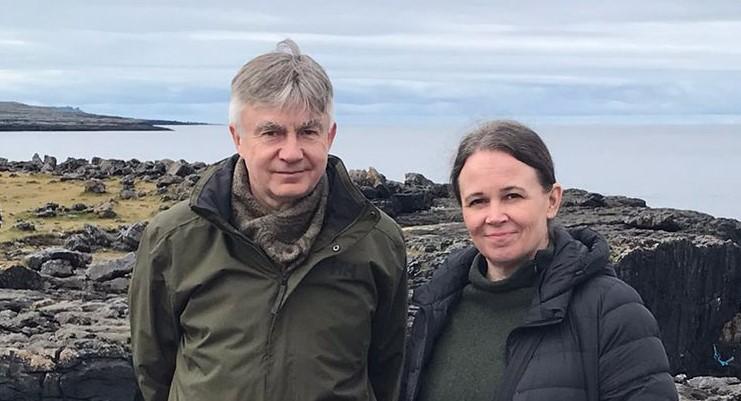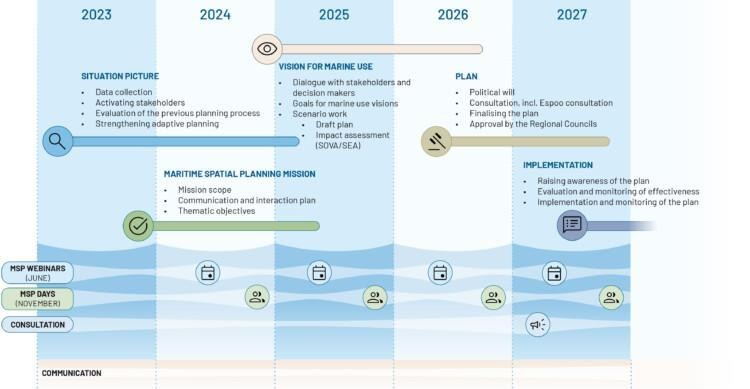Interaction in maritime spatial planning: learning from the past and with a touch of a new perspective
Maritime spatial planning is at a turning point. The coastal regional councils have initiated the update of Finland’s Maritime Spatial Plan 2030. The plan will be updated during 2024–2027. To support this work, an assessment of stakeholder engagement during the first round of maritime spatial planning (2017–2021) has been prepared, along with proposals for improving interaction for the second planning round. A new Interaction Plan for participants in the maritime spatial planning process has been developed based on the lessons learned. It provides an overview of maritime spatial planning and the opportunities for influence at various stages of planning. Mari Pohja-Mykrä, the coordinator of maritime spatial planning cooperation, reflects on stakeholder engagement at this critical juncture between planning rounds.
The Sea is for Everyone
The use of marine areas is undergoing a transformation. Alongside traditional uses of the sea, there is a rapidly growing interest in maritime energy production. The goals of the green transition and the geopolitical crisis have accelerated political will to increase offshore wind power production. Strengthening societal resilience and security in the face of climate change requires considering the needs of all maritime sectors. Nature – food – energy, all significant and interrelated themes, alongside other maritime activities. There is increasing consideration of marine multiuse, i.e., integrating various activities in the same areas. National security and security of supply considerations are also central to marine areas.
Finland’s maritime spatial planning (MSP) is at a crossroads. We have moved from the first planning round to the second, and MSP 2.0 is underway. The core message of the second round, The Sea is for Everyone, portrays the maritime area as a collective societal asset. Finland’s long coastline features diverse marine environments, and the land-sea interaction from catchment areas directly affects the maritime operational environment. Strengths and challenges vary across regions, and the benefits and drawbacks of maritime activities may be unevenly distributed. The eight coastal regional councils have taken up the task of preparing a maritime spatial plan that supports the sustainable use of maritime areas.
The Largest Planning Cooperation Ever in Finland
In January 2024, the coordination of MSP initiated an assessment of stakeholder engagement during the first round (2017–2021) and developing proposals for the second planning round. The aim was to evaluate the coverage of engagement at national, regional, and local levels, the integration of different sectors in MSP, and the implementation of equality in the planning process. The assessment and development proposals have informed the preparation of the Internal and External Interaction Plans for 2024–2027.
Let’s recall the outcome of the first planning round. Finland’s Maritime Spatial Plan 2030 has been in force since December 15, 2020, when all coastal regional councils approved the plan for their respective maritime areas. The plan is available in digital form in Finnish, Swedish, and English. The plan, divided into textual and cartographic sections, considers 11 maritime themes, their sustainable development visions, and sector-specific visions and roadmaps up to 2030. The goal behind sustainable planning solutions is to promote the achievement of good environmental status for marine areas.
Maritime spatial planning was a new planning instrument, whose implementation and final form were considered throughout the first planning round. The Land Use and Building Act (§67) provided a framework allowing authorities and communities to participate in the preparation of the Plan. The planning process relied primarily on collaborative efforts, with planning solutions developed in joint discussions with stakeholders and other experts. Authorities and communities whose areas of responsibility or tasks were significantly related to the plan were consulted, and opportunities were provided for others to review the preparatory materials and provide feedback. Two public consultation rounds were conducted during the planning process: the first focused on the situational analysis and extensive scenario work, and the second on vision work, the draft plan, and impact assessment.
In Finland, unlike in other EU countries, the responsibility for MSP lies at the regional level. The joint planning effort of the eight coastal regions is geographically and thematically larger than any other land use planning collaboration in Finland. Preparing a national maritime spatial plan that considers regional and even local characteristics, strengths, and challenges has required a new level of cooperation. To coordinate this planning collaboration, the maritime spatial planners of the coastal regional councils jointly established their own unit, the Coordination of Maritime Spatial Planning Cooperation, managed by the Regional Council of Southwest Finland. This MSP Coordination handles not only inter-regional planning cooperation but also collaboration with maritime sectors, authorities, and other experts.

Figure 1. Heikki Saarento, the head of the MSP Coordination Gropup and Mari Pohja-Mykrä, the Coordinator of MSP cooperation, in Ireland gaining insights into MSP interaction. In Ireland, the core message of MSP is that the sea brings joy to everyone!
Research on the Successes and Challenges of Maritime Spatial Planning in Finland
The sea has no boundaries, and therefore, MSP is also conducted across borders. In Finland, the Ministry of the Environment is responsible for interstate cooperation, but the MSP Coordination also actively participates in international cooperation. Finland is known worldwide for its collaborative MSP. The scenario work conducted with maritime stakeholders and authorities has been highlighted in the EU as a good example of stakeholder engagement (link to report).
The Finnish MSP process, its characteristics, implementation, successes, and failures have also been studied. The preparation of the Internal Interaction Plan has been supported by knowledge of how an ecosystem-based approach has enabled building understanding among maritime sectors and planners about regional connectivity and the socio-ecological system in which we are all interconnected through feedback loops of our actions (Lähde et al. 2024).
The aim of stakeholder engagement in MSP has been to maintain the motivation of maritime sectors to participate in the planning process linked to regional development, and it is hoped that engagement will also help build trust between maritime planners and sectors (Erkkilä-Välimäki et al. 2022). It has also been examined how Finland’s unique MSP structure can promote the blue economy while effectively supporting the good status of the marine environment (Haapasaari & Tatenhove, 2023).
Doing Things Even Better
The first planning round provided us with a good foundation. Now it’s time to do things even better. The ongoing second planning round is guided by the European Green Deal (2019) and its mandate for a “just, inclusive, and fair green transition for all people and regions,” which also steers MSP. Comprehensive, fair, and timely interaction in MSP is essential for successful stakeholder cooperation and for fostering a sense of psychological ownership of the maritime spatial plan among stakeholders.
The preparation of the Internal and External Interaction Plan for MSP has been guided by a working group representing coastal regional councils, the Ministry of the Environment, and the MSP Coordination, with WSP Finland Oy serving as the consultant.
Assessment of stakeholder engagement during the first round (2017–2021) and developing proposals for the second planning round, (in Finnish)
MSP Interaction plan 2024 – 2027
 Figure 2. The schedule and key interaction events for the 2nd round of MSP. Interested? You can find more information in the MSP Interaction Plan 2024-2027.
Figure 2. The schedule and key interaction events for the 2nd round of MSP. Interested? You can find more information in the MSP Interaction Plan 2024-2027.
